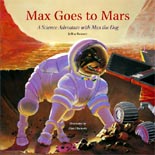Science Learning At Its Finest
I would have loved to have had Max Goes to Mars in my classroom when I was teaching. I know it would have become a favorite. Last Friday night a little former pupil, now 5, his parents, and I were having tea. He began to talk about Mars and spaceships. As it was getting late his father promised him he could look up Mars on the internet the next day. He asked, "There are book pages on the Internet about Mars?" I smiled to myself as here was a child who was read books from an infant, and he relys on books for information. When he was in my preschool he would take a stack of books to his cot at naptime. Next time I see him, I will give him my review copy of this great, informative book!
 Max Goes to Mars
Max Goes to Mars How does a dog go to Mars? This charming, yet realistic, book written by Dr. Jeffrey Bennett, tell us just how a dog and astronauts may take the first manned spaceship to Mars. Max Goes to Mars is jam-packed with interesting scientific facts and information in fictional story form, which always appeals to young readers. Even better, the scientific information is explained fully in readable, understandable terms without over-simplifying as can happen in children’s books.
The illustrations by Alan Okamoto make a perfect marriage with story, which is the ideal for picture books. The paintings also convey a technical detail and knowledge that young readers will pour over time and again, always finding something new to discover. Almost every page has sidebars for the readers who want to learn more about the science of space travel, Mars, and the ancient mythology about the planets. As well, there is an activity page near the end, which demonstrates the orbit of Mars through a movement exercise. Most special are the photographs of the real Max at the end. They are heartwarming and will bring the readers closer to Max and his adventures.
This book is extraordinary as it brings so many elements together in a nice harmony. Teachers will also find this book to be a marvelous core for the space unit. Most highly recommended for ages 4 – 10 and classrooms from pre-school through fifth grade.
The illustrations by Alan Okamoto make a perfect marriage with story, which is the ideal for picture books. The paintings also convey a technical detail and knowledge that young readers will pour over time and again, always finding something new to discover. Almost every page has sidebars for the readers who want to learn more about the science of space travel, Mars, and the ancient mythology about the planets. As well, there is an activity page near the end, which demonstrates the orbit of Mars through a movement exercise. Most special are the photographs of the real Max at the end. They are heartwarming and will bring the readers closer to Max and his adventures.
This book is extraordinary as it brings so many elements together in a nice harmony. Teachers will also find this book to be a marvelous core for the space unit. Most highly recommended for ages 4 – 10 and classrooms from pre-school through fifth grade.

0 Comments:
Post a Comment
<< Home